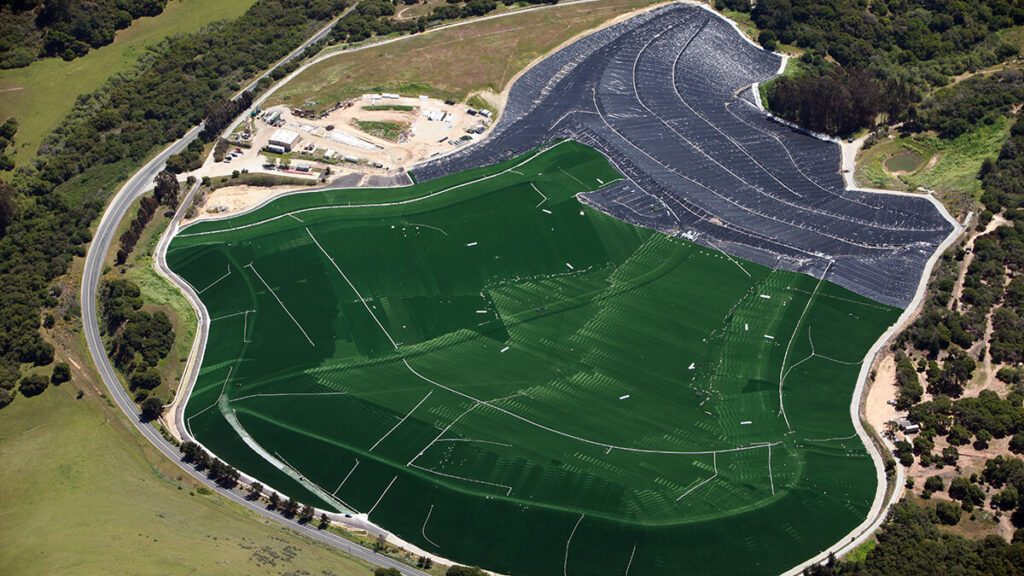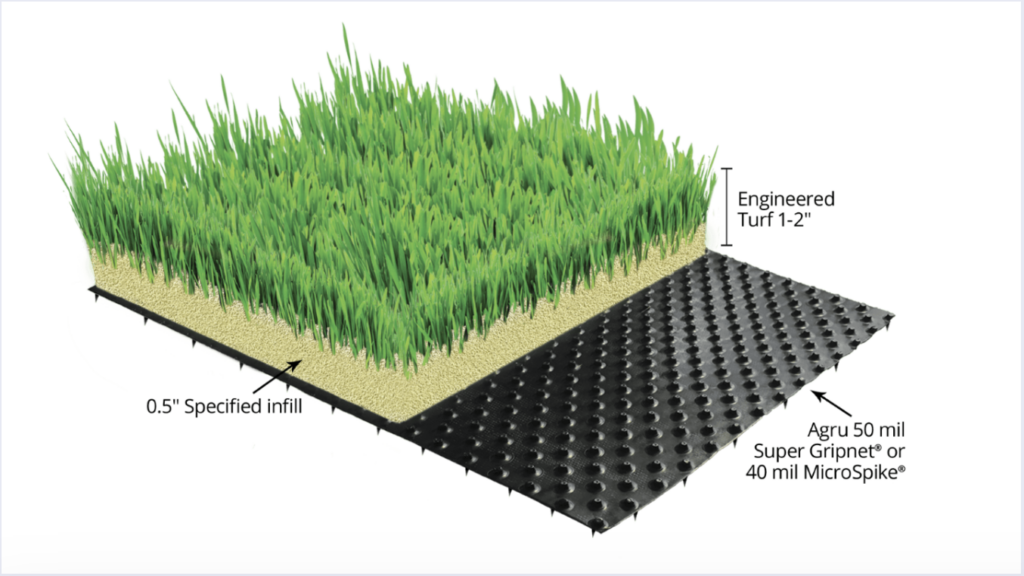Landfill cover soil is vital when addressing environmental safety and sustainability in waste management (1). As landfills, coal combustion residuals (CCR), and mining sites conclude their service life, there is a mandated obligation to close these sites to minimize their environmental impact. However, this process has become costly due to the rising cost of cover soil acquisition (2).
The excessive costs associated with excavating, loading, transporting, and spreading the soil make it one of the major operating expenses for site operators. Furthermore, the need for more suitable soil in some regions only compounds the issue.
This article explores the crucial role of cover soil, the rising costs associated with cover soil procurement, and novel geosynthetic solutions (3).

The crucial role of cover soil
Landfills, CCR, mining sites, and various industrial closure sites must meet stringent closure requirements (4). These requirements are set to ensure health, safety, and environmental sustainability. For instance, the soil cover in landfills minimizes windblown litter, reduces odors, deter birds, and limits rainwater infiltration (5).
In CCR sites, mining sites, and other industrial closures, the covering material prevents the spread of contaminants and stabilizes the site against erosion (6). In addition, the closure requirements ensure the long-term stability of these sites, especially after they have reached their capacity and are no longer in operation. They provide guidelines on properly closing these sites to prevent future environmental hazards, such as the leakage of hazardous substances into the surrounding environment.
Cover soil that meets the required geotechnical properties has become increasingly more expensive to acquire as each site has unique environmental requirements and unique geometries.
The rising costs of cover soil material
The soil used for landfill, CCR, mining, and industrial site closures often cannot be gathered nearby. Instead, it must come from specified borrow areas where the soil’s composition meets the required specifications for cover soil. Unfortunately, these borrow areas are becoming scarce, particularly in regions with high densities of industrial facilities, leading to increased competition for the remaining resources.
Even in those regions with available soil, there is the matter of excavation. The machinery, labor, and time required to excavate and load the soil onto trucks contribute significantly to the overall cost (7). Besides, this complex task requires precision and expertise, driving up operational expenses (8). The third factor is transportation. With borrow areas becoming scarce and potentially situated farther from closure sites, the cost of moving the excavated soil from its origin to its destination has risen sharply. These logistics involve long-distance hauling and fuel expenses, often subject to volatile price fluctuations.
Lastly, spreading the cover soil at the closure sites requires heavy machinery and skilled personnel to ensure that the soil is distributed evenly and effectively, forming a secure barrier against environmental hazards.
Paradoxically, the same cover soil used to protect the environment in one region can negatively affect the environment where it is extracted (9). The permitting for this process can be lengthy and costly in states like Florida, where land is at a premium and environmental regulations are stringent.
Eliminate cover soil costs with geosynthetics
Eliminating the hefty costs of cover soil is now achievable with geosynthetic solutions, such as ClosureTurf® (10). ClosureTurf, a Watershed Geo patented product, is a three-component system comprised of a structured geomembrane, an engineered turf, and a specified infill material.

This eco-friendly and cost-efficient solution revolutionizes waste management by eliminating traditional problems associated with soil cover (11). ClosureTurf’s main advantage lies in the liberation of additional airspace. Eliminating the soil layer allows for an extra two feet of airspace, assuming the final cover top elevation permits the landfill. The extra space opens avenues for additional income through expansion and lowers annual bonding obligations. It reduces the cost per ton of bonding requirements, potentially leading to a significant one-time financial credit.
Traditional practices often involve destroying native, undisturbed land to provide soil for landfill cover. ClosureTurf curbs this destruction, making a case for environmental and economic sensibility. It eliminates the need for construction vehicles to transport soil, reducing operational costs and environmental impacts. The ease of installation in small, incremental closures offered by ClosureTurf contributes to significant savings (13). It curtails fugitive emissions and leachate infiltration, directly benefiting the owner. Besides, its accelerated project schedule allows more significant closure acreage to be constructed than a traditional soil cover.
Post-closure care costs with ClosureTurf are strikingly lower than traditional systems. Moreover, annual maintenance costs are considerably lower than a conventional soil and vegetated cover system (13). ClosureTurf also shows superior resilience in extreme weather events, reducing maintenance and repair costs. Its long-term performance outshines traditional methods, with the turf and geomembrane lasting well beyond a century.
Finally, ClosureTurf excels in landfill gas collection, with its surficial gas collection system designed to allow landfill gas to rise to the waste surface. This increases the quantity and quality of collected gas, reducing potential oxygen intrusion and supporting a safer gas management system (12). Furthermore, ClosureTurf demonstrates significantly less leakage than traditional soil covers, as it includes an impermeable polyethylene plastic layer (14).
By adopting ClosureTurf, landfill operators can eliminate cover soil costs, increase efficiency, reduce environmental impact, and ensure predictable performance and post-closure maintenance costs, representing a viable solution to address the rising costs of landfill cover soil (Table 1).
Summary
The escalating costs of acquiring covering soil, a vital element in closing landfills, CCR, mining sites, and industrial facilities, have presented significant challenges for the waste management industry. The logistics of soil procurement, transportation, and application account for significant operational expenses, exacerbated by the scarcity of suitable soil in specific regions and stringent environmental regulations.
Additional costs associated with the soil borrow area development—particularly evident in states like Florida—have amplified on-site operators’ financial burden. However, innovative solutions such as ClosureTurf are poised to revolutionize the industry by addressing these cost issues head-on. ClosureTurf, an eco-friendly alternative to traditional soil cover, offers tangible benefits, including cost reduction, improved landfill gas management, increased landfill capacity, and minimized environmental impact.
As the waste management industry grapples with rising costs and environmental concerns, ClosureTurf represents a promising avenue for sustainable and cost-effective landfill management. Information courtesy of AGRU America.
Tables and Figures

References
(1) F. Metz and K. Ingold. “ Sustainable wastewater management: is it possible to regulate micropollution in the future by learning from the past? A policy analysis.” Sustainability. (2014).
(2) M. Petrović and Ž. Fiket. “Environmental damage caused by coal combustion residue disposal: A critical review of risk assessment methodologies.” Chemosphere. (2022).
(3) A. Allen. “Containment landfills: the myth of sustainability.” Engineering Geology. (2001).
(4) EPA. “Hazardous and Solid Waste Management System: Disposal of Coal Combustion Residuals From Electric Utilities; Legacy CCR Surface Impoundments.” Environmental Protection Agency. (2023).
(5) EA. “LFE6 – Guidance on using landfill.” Environment Agency. (2021).
(6) KENR. “Coal Combustion Residual Closure Analysis.” KirK Engineering & Natural Resources. Inc.. (2021).
(7) “Labor. Material and Equipment Utilization.” Carnegie Mellon University.
(8) “How Long Does It Take To Excavate A Construction Site?.” STEVENS.
(9) “Environmental Protection Performance Standards at Oil and Gas Well Sites.” Pennsylvania Department of Environmental Protection.
(10) J. Zheng et al. “Wind tunnel study of ClosureTurf landfill final cover system.” In Geo-Congress 2020: Engineering. Monitoring. and Management of Geotechnical Infrastructure. (2020).
(11) M. Zhu. “Geotechnical and Wind Performance of Engineered Turf Landfill Cover.” In Geo-Extreme 2021. (2021).
(12) J. K. Chetri and K. R. Reddy. “Advancements in municipal solid waste landfill cover system: A review.” Journal of the Indian Institute of Science. (2021).
(13) M. J. B. Alam and M. Aggarwal. “Investigating Sub-soil Moisture Variation of Engineered Turf Cover for Landfills Through Field Instrumentation.” In TMIC 2022 Slope Stability Conference (TMIC 2022). (2023).
(14) D. H. Cusworth et al. “Using remote sensing to detect. validate. and quantify methane emissions from California solid waste operations.” Environmental Research Letters. (2020).
 TEXTILES.ORG
TEXTILES.ORG


